Ergonomics Report: RA, Workplace Challenges, and Solutions
VerifiedAdded on 2022/09/05
|9
|3065
|14
Report
AI Summary
This report examines the case of Barbara, a maintenance operative diagnosed with rheumatoid arthritis (RA), and its implications in the workplace. It explores the challenges faced by arthritic workers, including pain, functional disability, and potential for long-term work disability, referencing studies on the prevalence and impact of RA. The report highlights risk factors, such as the nature of maintenance work and asbestos exposure, and discusses the importance of early diagnosis and treatment, including blood tests and X-rays. It emphasizes the need for workplace adjustments and provides recommendations for managing RA, aiming to improve the worker's quality of life and reduce the risk of unemployment and long-term sickness absence. The report also touches upon relevant legislation and guidance Barbara's manager should be aware of.

Running head: ERGONOMICS
Ergonomics
Name of the Student
Name of the University
Author Note
Ergonomics
Name of the Student
Name of the University
Author Note
Paraphrase This Document
Need a fresh take? Get an instant paraphrase of this document with our AI Paraphraser
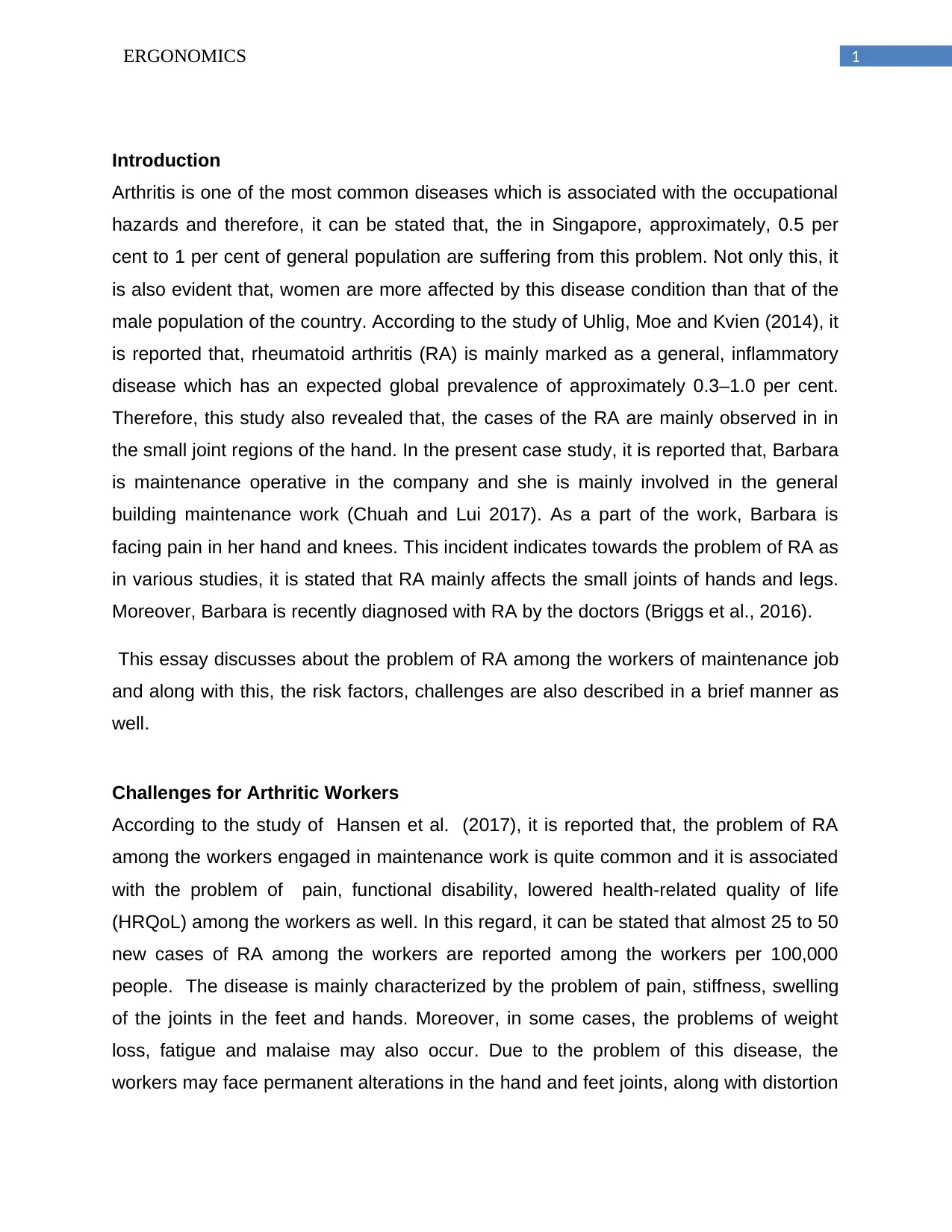
1ERGONOMICS
Introduction
Arthritis is one of the most common diseases which is associated with the occupational
hazards and therefore, it can be stated that, the in Singapore, approximately, 0.5 per
cent to 1 per cent of general population are suffering from this problem. Not only this, it
is also evident that, women are more affected by this disease condition than that of the
male population of the country. According to the study of Uhlig, Moe and Kvien (2014), it
is reported that, rheumatoid arthritis (RA) is mainly marked as a general, inflammatory
disease which has an expected global prevalence of approximately 0.3–1.0 per cent.
Therefore, this study also revealed that, the cases of the RA are mainly observed in in
the small joint regions of the hand. In the present case study, it is reported that, Barbara
is maintenance operative in the company and she is mainly involved in the general
building maintenance work (Chuah and Lui 2017). As a part of the work, Barbara is
facing pain in her hand and knees. This incident indicates towards the problem of RA as
in various studies, it is stated that RA mainly affects the small joints of hands and legs.
Moreover, Barbara is recently diagnosed with RA by the doctors (Briggs et al., 2016).
This essay discusses about the problem of RA among the workers of maintenance job
and along with this, the risk factors, challenges are also described in a brief manner as
well.
Challenges for Arthritic Workers
According to the study of Hansen et al. (2017), it is reported that, the problem of RA
among the workers engaged in maintenance work is quite common and it is associated
with the problem of pain, functional disability, lowered health-related quality of life
(HRQoL) among the workers as well. In this regard, it can be stated that almost 25 to 50
new cases of RA among the workers are reported among the workers per 100,000
people. The disease is mainly characterized by the problem of pain, stiffness, swelling
of the joints in the feet and hands. Moreover, in some cases, the problems of weight
loss, fatigue and malaise may also occur. Due to the problem of this disease, the
workers may face permanent alterations in the hand and feet joints, along with distortion
Introduction
Arthritis is one of the most common diseases which is associated with the occupational
hazards and therefore, it can be stated that, the in Singapore, approximately, 0.5 per
cent to 1 per cent of general population are suffering from this problem. Not only this, it
is also evident that, women are more affected by this disease condition than that of the
male population of the country. According to the study of Uhlig, Moe and Kvien (2014), it
is reported that, rheumatoid arthritis (RA) is mainly marked as a general, inflammatory
disease which has an expected global prevalence of approximately 0.3–1.0 per cent.
Therefore, this study also revealed that, the cases of the RA are mainly observed in in
the small joint regions of the hand. In the present case study, it is reported that, Barbara
is maintenance operative in the company and she is mainly involved in the general
building maintenance work (Chuah and Lui 2017). As a part of the work, Barbara is
facing pain in her hand and knees. This incident indicates towards the problem of RA as
in various studies, it is stated that RA mainly affects the small joints of hands and legs.
Moreover, Barbara is recently diagnosed with RA by the doctors (Briggs et al., 2016).
This essay discusses about the problem of RA among the workers of maintenance job
and along with this, the risk factors, challenges are also described in a brief manner as
well.
Challenges for Arthritic Workers
According to the study of Hansen et al. (2017), it is reported that, the problem of RA
among the workers engaged in maintenance work is quite common and it is associated
with the problem of pain, functional disability, lowered health-related quality of life
(HRQoL) among the workers as well. In this regard, it can be stated that almost 25 to 50
new cases of RA among the workers are reported among the workers per 100,000
people. The disease is mainly characterized by the problem of pain, stiffness, swelling
of the joints in the feet and hands. Moreover, in some cases, the problems of weight
loss, fatigue and malaise may also occur. Due to the problem of this disease, the
workers may face permanent alterations in the hand and feet joints, along with distortion
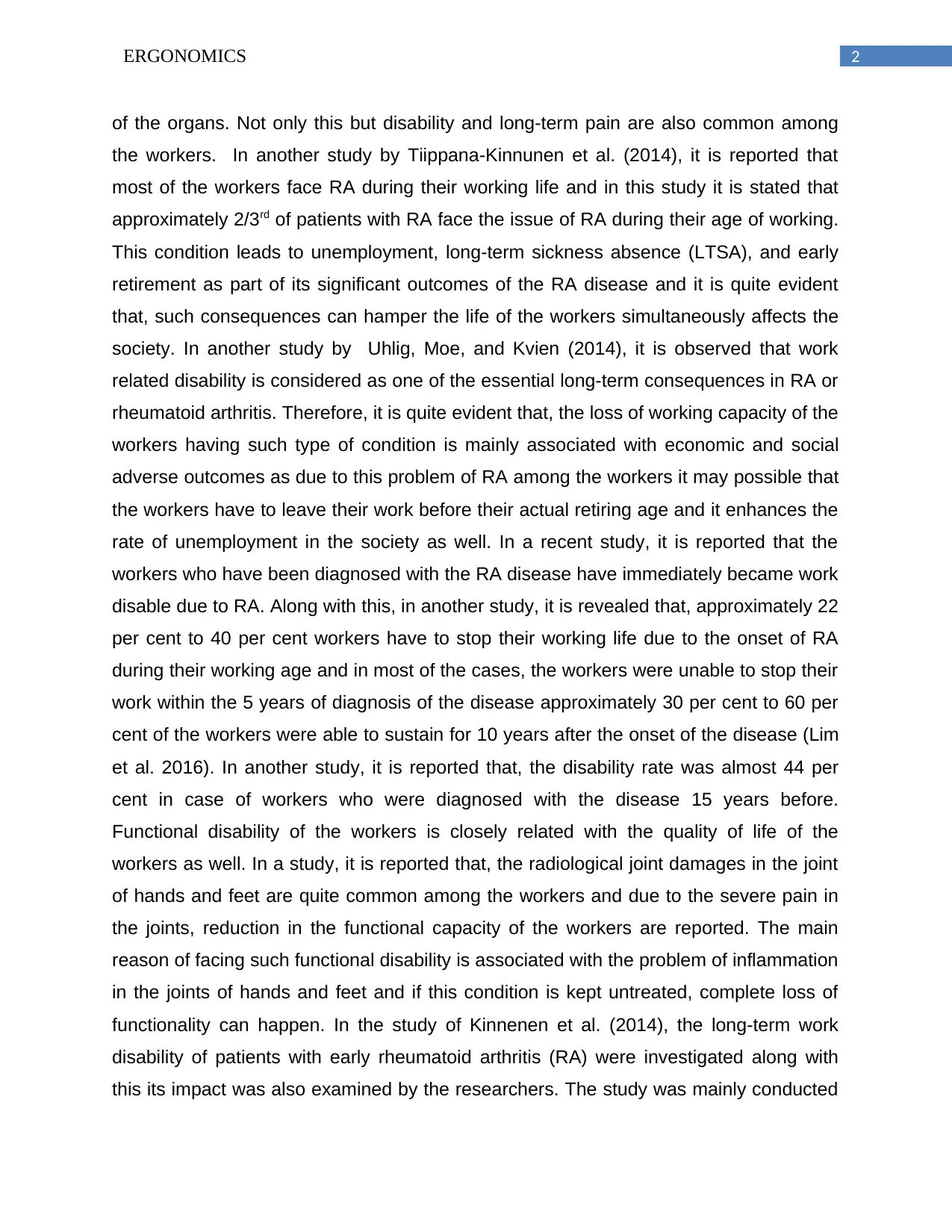
2ERGONOMICS
of the organs. Not only this but disability and long-term pain are also common among
the workers. In another study by Tiippana-Kinnunen et al. (2014), it is reported that
most of the workers face RA during their working life and in this study it is stated that
approximately 2/3rd of patients with RA face the issue of RA during their age of working.
This condition leads to unemployment, long-term sickness absence (LTSA), and early
retirement as part of its significant outcomes of the RA disease and it is quite evident
that, such consequences can hamper the life of the workers simultaneously affects the
society. In another study by Uhlig, Moe, and Kvien (2014), it is observed that work
related disability is considered as one of the essential long-term consequences in RA or
rheumatoid arthritis. Therefore, it is quite evident that, the loss of working capacity of the
workers having such type of condition is mainly associated with economic and social
adverse outcomes as due to this problem of RA among the workers it may possible that
the workers have to leave their work before their actual retiring age and it enhances the
rate of unemployment in the society as well. In a recent study, it is reported that the
workers who have been diagnosed with the RA disease have immediately became work
disable due to RA. Along with this, in another study, it is revealed that, approximately 22
per cent to 40 per cent workers have to stop their working life due to the onset of RA
during their working age and in most of the cases, the workers were unable to stop their
work within the 5 years of diagnosis of the disease approximately 30 per cent to 60 per
cent of the workers were able to sustain for 10 years after the onset of the disease (Lim
et al. 2016). In another study, it is reported that, the disability rate was almost 44 per
cent in case of workers who were diagnosed with the disease 15 years before.
Functional disability of the workers is closely related with the quality of life of the
workers as well. In a study, it is reported that, the radiological joint damages in the joint
of hands and feet are quite common among the workers and due to the severe pain in
the joints, reduction in the functional capacity of the workers are reported. The main
reason of facing such functional disability is associated with the problem of inflammation
in the joints of hands and feet and if this condition is kept untreated, complete loss of
functionality can happen. In the study of Kinnenen et al. (2014), the long-term work
disability of patients with early rheumatoid arthritis (RA) were investigated along with
this its impact was also examined by the researchers. The study was mainly conducted
of the organs. Not only this but disability and long-term pain are also common among
the workers. In another study by Tiippana-Kinnunen et al. (2014), it is reported that
most of the workers face RA during their working life and in this study it is stated that
approximately 2/3rd of patients with RA face the issue of RA during their age of working.
This condition leads to unemployment, long-term sickness absence (LTSA), and early
retirement as part of its significant outcomes of the RA disease and it is quite evident
that, such consequences can hamper the life of the workers simultaneously affects the
society. In another study by Uhlig, Moe, and Kvien (2014), it is observed that work
related disability is considered as one of the essential long-term consequences in RA or
rheumatoid arthritis. Therefore, it is quite evident that, the loss of working capacity of the
workers having such type of condition is mainly associated with economic and social
adverse outcomes as due to this problem of RA among the workers it may possible that
the workers have to leave their work before their actual retiring age and it enhances the
rate of unemployment in the society as well. In a recent study, it is reported that the
workers who have been diagnosed with the RA disease have immediately became work
disable due to RA. Along with this, in another study, it is revealed that, approximately 22
per cent to 40 per cent workers have to stop their working life due to the onset of RA
during their working age and in most of the cases, the workers were unable to stop their
work within the 5 years of diagnosis of the disease approximately 30 per cent to 60 per
cent of the workers were able to sustain for 10 years after the onset of the disease (Lim
et al. 2016). In another study, it is reported that, the disability rate was almost 44 per
cent in case of workers who were diagnosed with the disease 15 years before.
Functional disability of the workers is closely related with the quality of life of the
workers as well. In a study, it is reported that, the radiological joint damages in the joint
of hands and feet are quite common among the workers and due to the severe pain in
the joints, reduction in the functional capacity of the workers are reported. The main
reason of facing such functional disability is associated with the problem of inflammation
in the joints of hands and feet and if this condition is kept untreated, complete loss of
functionality can happen. In the study of Kinnenen et al. (2014), the long-term work
disability of patients with early rheumatoid arthritis (RA) were investigated along with
this its impact was also examined by the researchers. The study was mainly conducted
⊘ This is a preview!⊘
Do you want full access?
Subscribe today to unlock all pages.

Trusted by 1+ million students worldwide
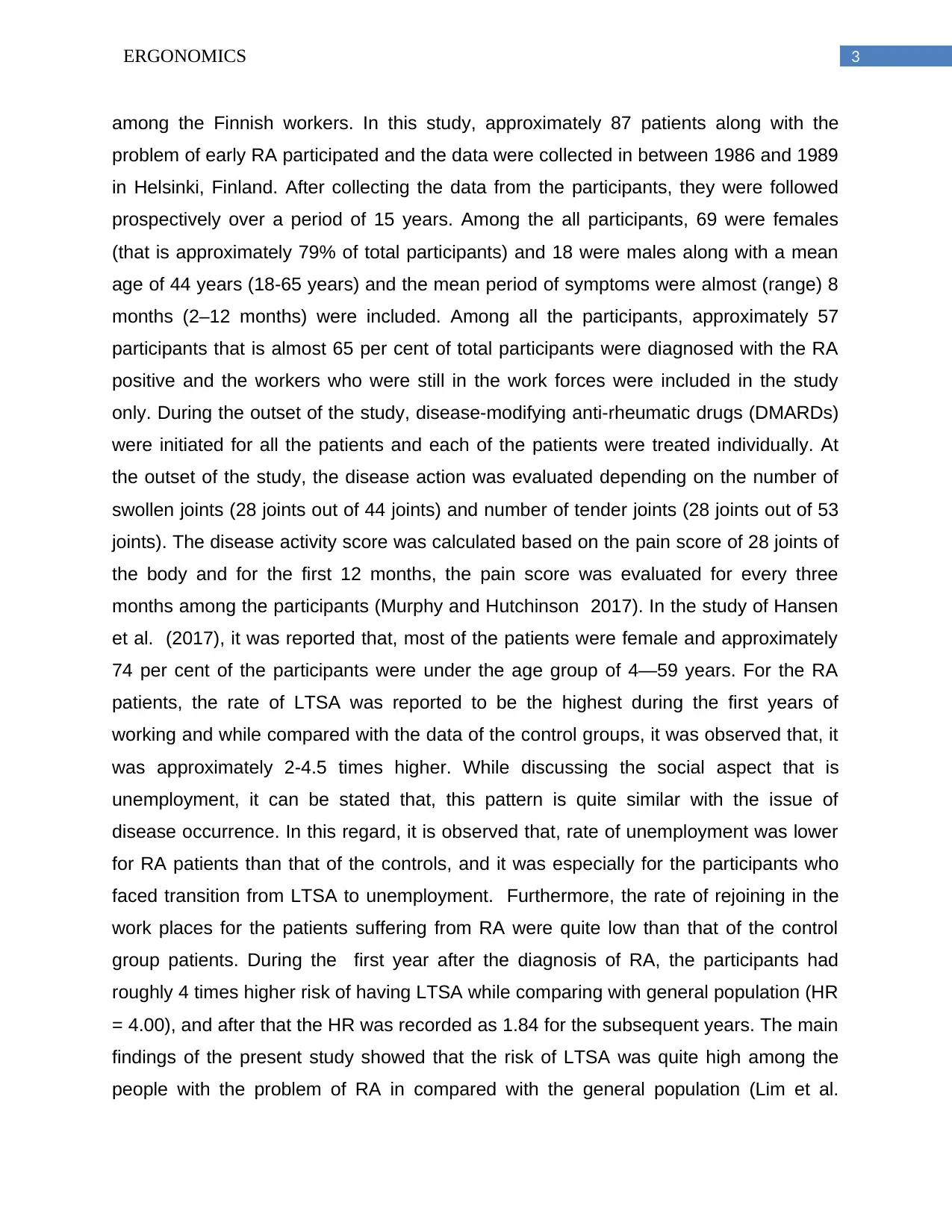
3ERGONOMICS
among the Finnish workers. In this study, approximately 87 patients along with the
problem of early RA participated and the data were collected in between 1986 and 1989
in Helsinki, Finland. After collecting the data from the participants, they were followed
prospectively over a period of 15 years. Among the all participants, 69 were females
(that is approximately 79% of total participants) and 18 were males along with a mean
age of 44 years (18-65 years) and the mean period of symptoms were almost (range) 8
months (2–12 months) were included. Among all the participants, approximately 57
participants that is almost 65 per cent of total participants were diagnosed with the RA
positive and the workers who were still in the work forces were included in the study
only. During the outset of the study, disease-modifying anti-rheumatic drugs (DMARDs)
were initiated for all the patients and each of the patients were treated individually. At
the outset of the study, the disease action was evaluated depending on the number of
swollen joints (28 joints out of 44 joints) and number of tender joints (28 joints out of 53
joints). The disease activity score was calculated based on the pain score of 28 joints of
the body and for the first 12 months, the pain score was evaluated for every three
months among the participants (Murphy and Hutchinson 2017). In the study of Hansen
et al. (2017), it was reported that, most of the patients were female and approximately
74 per cent of the participants were under the age group of 4—59 years. For the RA
patients, the rate of LTSA was reported to be the highest during the first years of
working and while compared with the data of the control groups, it was observed that, it
was approximately 2-4.5 times higher. While discussing the social aspect that is
unemployment, it can be stated that, this pattern is quite similar with the issue of
disease occurrence. In this regard, it is observed that, rate of unemployment was lower
for RA patients than that of the controls, and it was especially for the participants who
faced transition from LTSA to unemployment. Furthermore, the rate of rejoining in the
work places for the patients suffering from RA were quite low than that of the control
group patients. During the first year after the diagnosis of RA, the participants had
roughly 4 times higher risk of having LTSA while comparing with general population (HR
= 4.00), and after that the HR was recorded as 1.84 for the subsequent years. The main
findings of the present study showed that the risk of LTSA was quite high among the
people with the problem of RA in compared with the general population (Lim et al.
among the Finnish workers. In this study, approximately 87 patients along with the
problem of early RA participated and the data were collected in between 1986 and 1989
in Helsinki, Finland. After collecting the data from the participants, they were followed
prospectively over a period of 15 years. Among the all participants, 69 were females
(that is approximately 79% of total participants) and 18 were males along with a mean
age of 44 years (18-65 years) and the mean period of symptoms were almost (range) 8
months (2–12 months) were included. Among all the participants, approximately 57
participants that is almost 65 per cent of total participants were diagnosed with the RA
positive and the workers who were still in the work forces were included in the study
only. During the outset of the study, disease-modifying anti-rheumatic drugs (DMARDs)
were initiated for all the patients and each of the patients were treated individually. At
the outset of the study, the disease action was evaluated depending on the number of
swollen joints (28 joints out of 44 joints) and number of tender joints (28 joints out of 53
joints). The disease activity score was calculated based on the pain score of 28 joints of
the body and for the first 12 months, the pain score was evaluated for every three
months among the participants (Murphy and Hutchinson 2017). In the study of Hansen
et al. (2017), it was reported that, most of the patients were female and approximately
74 per cent of the participants were under the age group of 4—59 years. For the RA
patients, the rate of LTSA was reported to be the highest during the first years of
working and while compared with the data of the control groups, it was observed that, it
was approximately 2-4.5 times higher. While discussing the social aspect that is
unemployment, it can be stated that, this pattern is quite similar with the issue of
disease occurrence. In this regard, it is observed that, rate of unemployment was lower
for RA patients than that of the controls, and it was especially for the participants who
faced transition from LTSA to unemployment. Furthermore, the rate of rejoining in the
work places for the patients suffering from RA were quite low than that of the control
group patients. During the first year after the diagnosis of RA, the participants had
roughly 4 times higher risk of having LTSA while comparing with general population (HR
= 4.00), and after that the HR was recorded as 1.84 for the subsequent years. The main
findings of the present study showed that the risk of LTSA was quite high among the
people with the problem of RA in compared with the general population (Lim et al.
Paraphrase This Document
Need a fresh take? Get an instant paraphrase of this document with our AI Paraphraser
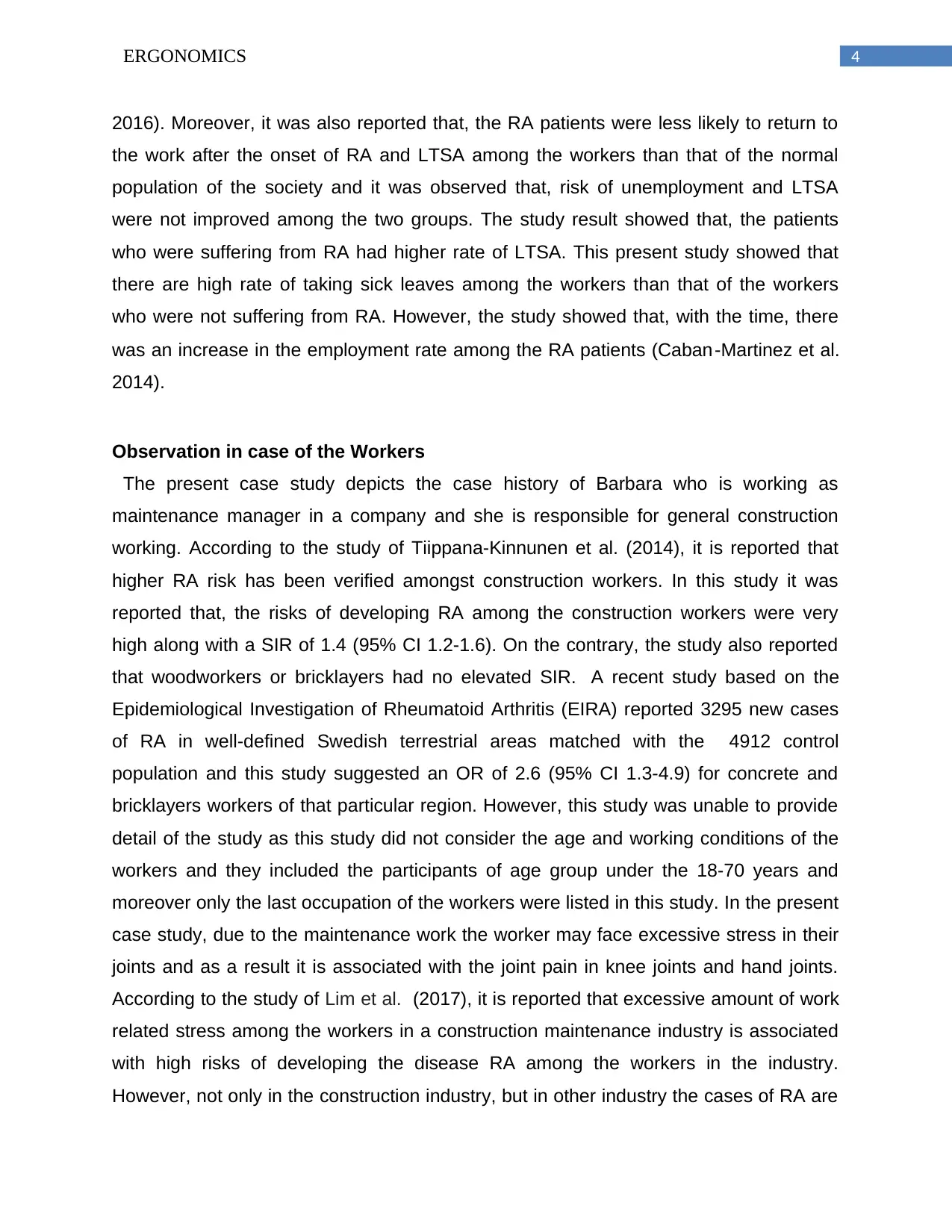
4ERGONOMICS
2016). Moreover, it was also reported that, the RA patients were less likely to return to
the work after the onset of RA and LTSA among the workers than that of the normal
population of the society and it was observed that, risk of unemployment and LTSA
were not improved among the two groups. The study result showed that, the patients
who were suffering from RA had higher rate of LTSA. This present study showed that
there are high rate of taking sick leaves among the workers than that of the workers
who were not suffering from RA. However, the study showed that, with the time, there
was an increase in the employment rate among the RA patients (Caban‐Martinez et al.
2014).
Observation in case of the Workers
The present case study depicts the case history of Barbara who is working as
maintenance manager in a company and she is responsible for general construction
working. According to the study of Tiippana-Kinnunen et al. (2014), it is reported that
higher RA risk has been verified amongst construction workers. In this study it was
reported that, the risks of developing RA among the construction workers were very
high along with a SIR of 1.4 (95% CI 1.2-1.6). On the contrary, the study also reported
that woodworkers or bricklayers had no elevated SIR. A recent study based on the
Epidemiological Investigation of Rheumatoid Arthritis (EIRA) reported 3295 new cases
of RA in well-defined Swedish terrestrial areas matched with the 4912 control
population and this study suggested an OR of 2.6 (95% CI 1.3-4.9) for concrete and
bricklayers workers of that particular region. However, this study was unable to provide
detail of the study as this study did not consider the age and working conditions of the
workers and they included the participants of age group under the 18-70 years and
moreover only the last occupation of the workers were listed in this study. In the present
case study, due to the maintenance work the worker may face excessive stress in their
joints and as a result it is associated with the joint pain in knee joints and hand joints.
According to the study of Lim et al. (2017), it is reported that excessive amount of work
related stress among the workers in a construction maintenance industry is associated
with high risks of developing the disease RA among the workers in the industry.
However, not only in the construction industry, but in other industry the cases of RA are
2016). Moreover, it was also reported that, the RA patients were less likely to return to
the work after the onset of RA and LTSA among the workers than that of the normal
population of the society and it was observed that, risk of unemployment and LTSA
were not improved among the two groups. The study result showed that, the patients
who were suffering from RA had higher rate of LTSA. This present study showed that
there are high rate of taking sick leaves among the workers than that of the workers
who were not suffering from RA. However, the study showed that, with the time, there
was an increase in the employment rate among the RA patients (Caban‐Martinez et al.
2014).
Observation in case of the Workers
The present case study depicts the case history of Barbara who is working as
maintenance manager in a company and she is responsible for general construction
working. According to the study of Tiippana-Kinnunen et al. (2014), it is reported that
higher RA risk has been verified amongst construction workers. In this study it was
reported that, the risks of developing RA among the construction workers were very
high along with a SIR of 1.4 (95% CI 1.2-1.6). On the contrary, the study also reported
that woodworkers or bricklayers had no elevated SIR. A recent study based on the
Epidemiological Investigation of Rheumatoid Arthritis (EIRA) reported 3295 new cases
of RA in well-defined Swedish terrestrial areas matched with the 4912 control
population and this study suggested an OR of 2.6 (95% CI 1.3-4.9) for concrete and
bricklayers workers of that particular region. However, this study was unable to provide
detail of the study as this study did not consider the age and working conditions of the
workers and they included the participants of age group under the 18-70 years and
moreover only the last occupation of the workers were listed in this study. In the present
case study, due to the maintenance work the worker may face excessive stress in their
joints and as a result it is associated with the joint pain in knee joints and hand joints.
According to the study of Lim et al. (2017), it is reported that excessive amount of work
related stress among the workers in a construction maintenance industry is associated
with high risks of developing the disease RA among the workers in the industry.
However, not only in the construction industry, but in other industry the cases of RA are
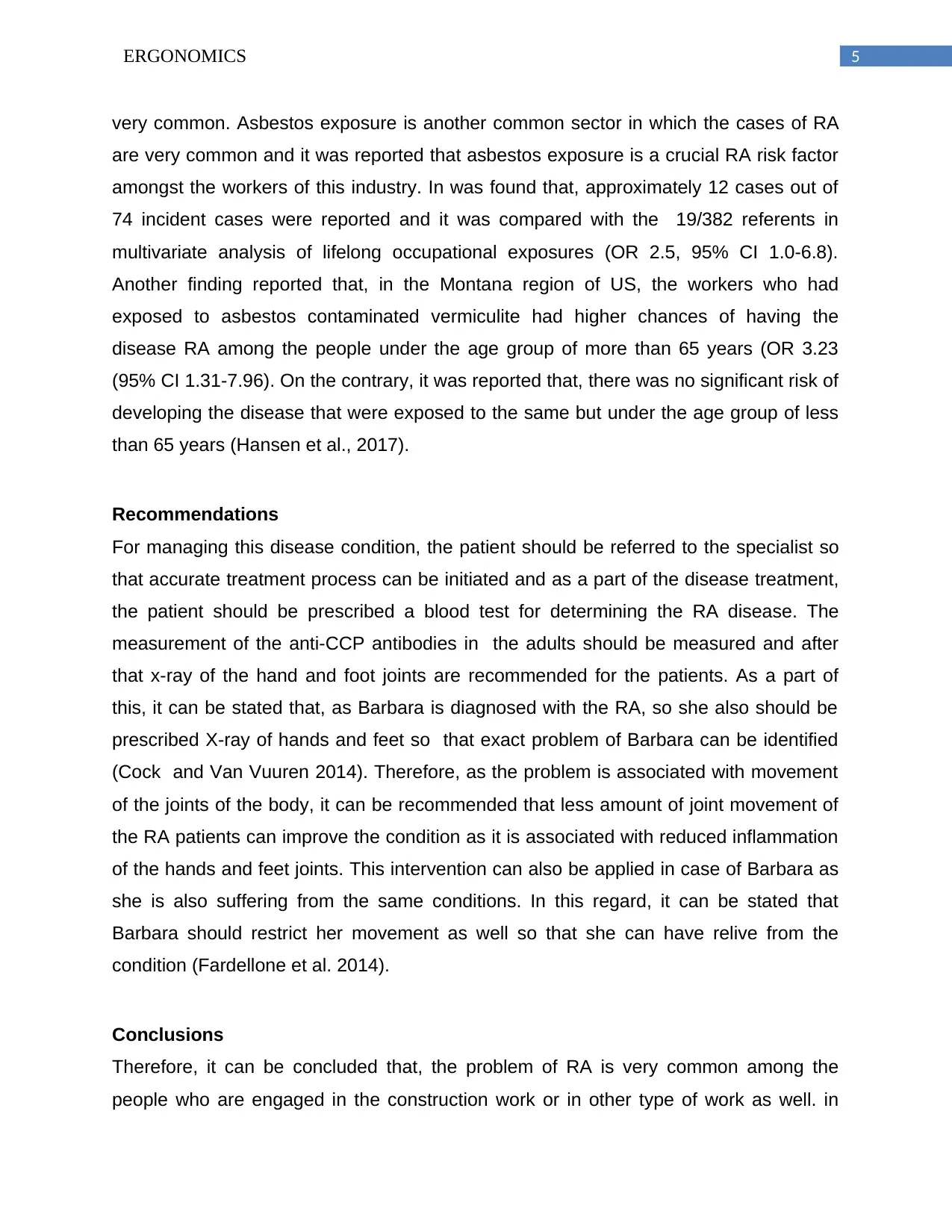
5ERGONOMICS
very common. Asbestos exposure is another common sector in which the cases of RA
are very common and it was reported that asbestos exposure is a crucial RA risk factor
amongst the workers of this industry. In was found that, approximately 12 cases out of
74 incident cases were reported and it was compared with the 19/382 referents in
multivariate analysis of lifelong occupational exposures (OR 2.5, 95% CI 1.0-6.8).
Another finding reported that, in the Montana region of US, the workers who had
exposed to asbestos contaminated vermiculite had higher chances of having the
disease RA among the people under the age group of more than 65 years (OR 3.23
(95% CI 1.31-7.96). On the contrary, it was reported that, there was no significant risk of
developing the disease that were exposed to the same but under the age group of less
than 65 years (Hansen et al., 2017).
Recommendations
For managing this disease condition, the patient should be referred to the specialist so
that accurate treatment process can be initiated and as a part of the disease treatment,
the patient should be prescribed a blood test for determining the RA disease. The
measurement of the anti-CCP antibodies in the adults should be measured and after
that x-ray of the hand and foot joints are recommended for the patients. As a part of
this, it can be stated that, as Barbara is diagnosed with the RA, so she also should be
prescribed X-ray of hands and feet so that exact problem of Barbara can be identified
(Cock and Van Vuuren 2014). Therefore, as the problem is associated with movement
of the joints of the body, it can be recommended that less amount of joint movement of
the RA patients can improve the condition as it is associated with reduced inflammation
of the hands and feet joints. This intervention can also be applied in case of Barbara as
she is also suffering from the same conditions. In this regard, it can be stated that
Barbara should restrict her movement as well so that she can have relive from the
condition (Fardellone et al. 2014).
Conclusions
Therefore, it can be concluded that, the problem of RA is very common among the
people who are engaged in the construction work or in other type of work as well. in
very common. Asbestos exposure is another common sector in which the cases of RA
are very common and it was reported that asbestos exposure is a crucial RA risk factor
amongst the workers of this industry. In was found that, approximately 12 cases out of
74 incident cases were reported and it was compared with the 19/382 referents in
multivariate analysis of lifelong occupational exposures (OR 2.5, 95% CI 1.0-6.8).
Another finding reported that, in the Montana region of US, the workers who had
exposed to asbestos contaminated vermiculite had higher chances of having the
disease RA among the people under the age group of more than 65 years (OR 3.23
(95% CI 1.31-7.96). On the contrary, it was reported that, there was no significant risk of
developing the disease that were exposed to the same but under the age group of less
than 65 years (Hansen et al., 2017).
Recommendations
For managing this disease condition, the patient should be referred to the specialist so
that accurate treatment process can be initiated and as a part of the disease treatment,
the patient should be prescribed a blood test for determining the RA disease. The
measurement of the anti-CCP antibodies in the adults should be measured and after
that x-ray of the hand and foot joints are recommended for the patients. As a part of
this, it can be stated that, as Barbara is diagnosed with the RA, so she also should be
prescribed X-ray of hands and feet so that exact problem of Barbara can be identified
(Cock and Van Vuuren 2014). Therefore, as the problem is associated with movement
of the joints of the body, it can be recommended that less amount of joint movement of
the RA patients can improve the condition as it is associated with reduced inflammation
of the hands and feet joints. This intervention can also be applied in case of Barbara as
she is also suffering from the same conditions. In this regard, it can be stated that
Barbara should restrict her movement as well so that she can have relive from the
condition (Fardellone et al. 2014).
Conclusions
Therefore, it can be concluded that, the problem of RA is very common among the
people who are engaged in the construction work or in other type of work as well. in
⊘ This is a preview!⊘
Do you want full access?
Subscribe today to unlock all pages.

Trusted by 1+ million students worldwide

6ERGONOMICS
Singapore, approximately, 0.5 per cent to 1 per cent of general population are suffering
from this problem. Not only this, it is also evident that, women are more affected by this
disease condition than that of the male population of the country. the cases of the RA
are mainly observed in in the small joint regions of the hand. the present case study
depicts the history of Barbara who is a maintenance operative in the company and she
is mainly involved in the general building maintenance work. The disease is mainly
characterized by the problem of pain, stiffness, swelling of the joints in the feet and
hands. Moreover, in some cases, the problems of weight loss, fatigue and malaise may
also occur. Due to the problem of this disease, the workers may face permanent
alterations in the hand and feet joints, along with distortion of the organs. RA patients
were less likely to return to the work after the onset of RA and LTSA among the workers
than that of the normal population of the society.
Singapore, approximately, 0.5 per cent to 1 per cent of general population are suffering
from this problem. Not only this, it is also evident that, women are more affected by this
disease condition than that of the male population of the country. the cases of the RA
are mainly observed in in the small joint regions of the hand. the present case study
depicts the history of Barbara who is a maintenance operative in the company and she
is mainly involved in the general building maintenance work. The disease is mainly
characterized by the problem of pain, stiffness, swelling of the joints in the feet and
hands. Moreover, in some cases, the problems of weight loss, fatigue and malaise may
also occur. Due to the problem of this disease, the workers may face permanent
alterations in the hand and feet joints, along with distortion of the organs. RA patients
were less likely to return to the work after the onset of RA and LTSA among the workers
than that of the normal population of the society.
Paraphrase This Document
Need a fresh take? Get an instant paraphrase of this document with our AI Paraphraser
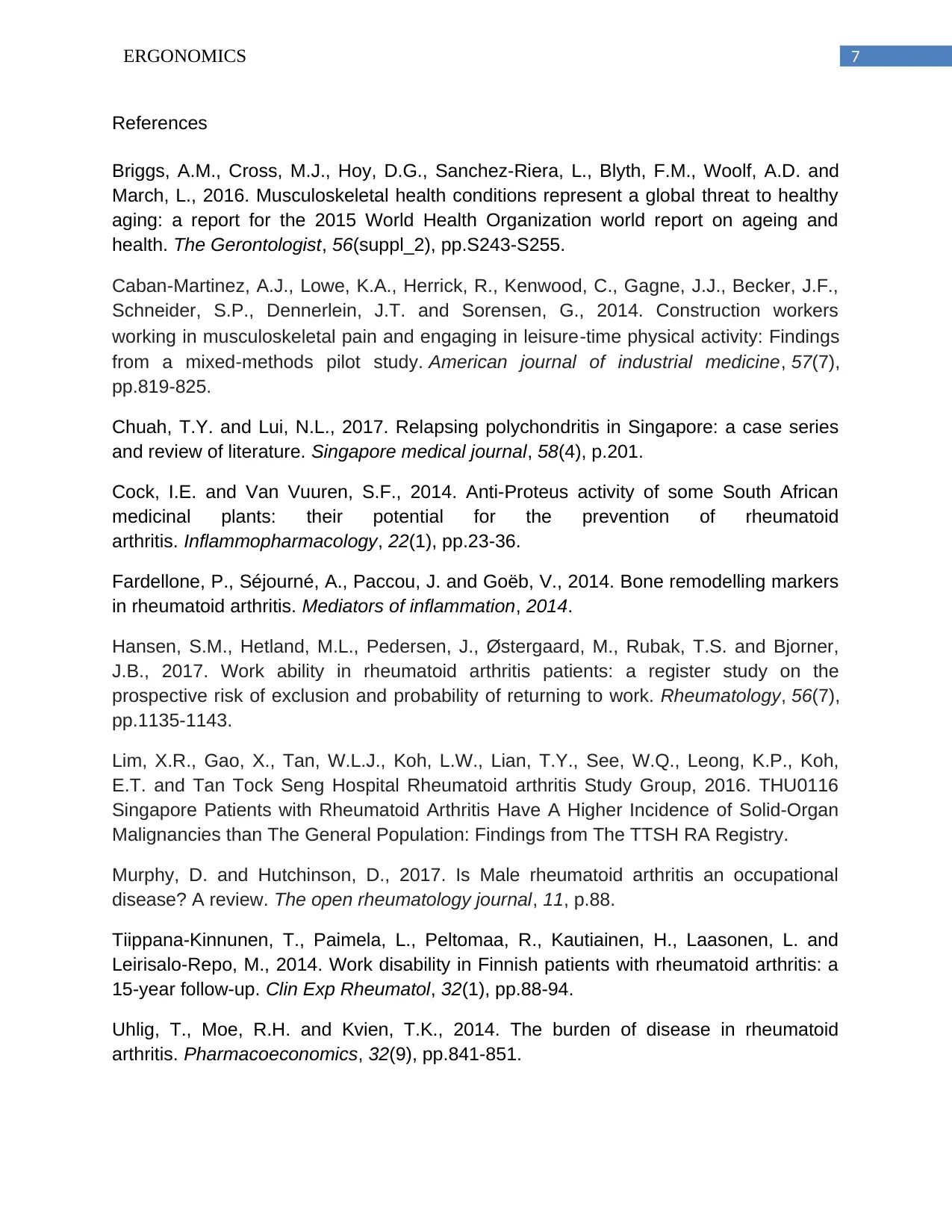
7ERGONOMICS
References
Briggs, A.M., Cross, M.J., Hoy, D.G., Sanchez-Riera, L., Blyth, F.M., Woolf, A.D. and
March, L., 2016. Musculoskeletal health conditions represent a global threat to healthy
aging: a report for the 2015 World Health Organization world report on ageing and
health. The Gerontologist, 56(suppl_2), pp.S243-S255.
Caban‐Martinez, A.J., Lowe, K.A., Herrick, R., Kenwood, C., Gagne, J.J., Becker, J.F.,
Schneider, S.P., Dennerlein, J.T. and Sorensen, G., 2014. Construction workers
working in musculoskeletal pain and engaging in leisure‐time physical activity: Findings
from a mixed‐methods pilot study. American journal of industrial medicine, 57(7),
pp.819-825.
Chuah, T.Y. and Lui, N.L., 2017. Relapsing polychondritis in Singapore: a case series
and review of literature. Singapore medical journal, 58(4), p.201.
Cock, I.E. and Van Vuuren, S.F., 2014. Anti-Proteus activity of some South African
medicinal plants: their potential for the prevention of rheumatoid
arthritis. Inflammopharmacology, 22(1), pp.23-36.
Fardellone, P., Séjourné, A., Paccou, J. and Goëb, V., 2014. Bone remodelling markers
in rheumatoid arthritis. Mediators of inflammation, 2014.
Hansen, S.M., Hetland, M.L., Pedersen, J., Østergaard, M., Rubak, T.S. and Bjorner,
J.B., 2017. Work ability in rheumatoid arthritis patients: a register study on the
prospective risk of exclusion and probability of returning to work. Rheumatology, 56(7),
pp.1135-1143.
Lim, X.R., Gao, X., Tan, W.L.J., Koh, L.W., Lian, T.Y., See, W.Q., Leong, K.P., Koh,
E.T. and Tan Tock Seng Hospital Rheumatoid arthritis Study Group, 2016. THU0116
Singapore Patients with Rheumatoid Arthritis Have A Higher Incidence of Solid-Organ
Malignancies than The General Population: Findings from The TTSH RA Registry.
Murphy, D. and Hutchinson, D., 2017. Is Male rheumatoid arthritis an occupational
disease? A review. The open rheumatology journal, 11, p.88.
Tiippana-Kinnunen, T., Paimela, L., Peltomaa, R., Kautiainen, H., Laasonen, L. and
Leirisalo-Repo, M., 2014. Work disability in Finnish patients with rheumatoid arthritis: a
15-year follow-up. Clin Exp Rheumatol, 32(1), pp.88-94.
Uhlig, T., Moe, R.H. and Kvien, T.K., 2014. The burden of disease in rheumatoid
arthritis. Pharmacoeconomics, 32(9), pp.841-851.
References
Briggs, A.M., Cross, M.J., Hoy, D.G., Sanchez-Riera, L., Blyth, F.M., Woolf, A.D. and
March, L., 2016. Musculoskeletal health conditions represent a global threat to healthy
aging: a report for the 2015 World Health Organization world report on ageing and
health. The Gerontologist, 56(suppl_2), pp.S243-S255.
Caban‐Martinez, A.J., Lowe, K.A., Herrick, R., Kenwood, C., Gagne, J.J., Becker, J.F.,
Schneider, S.P., Dennerlein, J.T. and Sorensen, G., 2014. Construction workers
working in musculoskeletal pain and engaging in leisure‐time physical activity: Findings
from a mixed‐methods pilot study. American journal of industrial medicine, 57(7),
pp.819-825.
Chuah, T.Y. and Lui, N.L., 2017. Relapsing polychondritis in Singapore: a case series
and review of literature. Singapore medical journal, 58(4), p.201.
Cock, I.E. and Van Vuuren, S.F., 2014. Anti-Proteus activity of some South African
medicinal plants: their potential for the prevention of rheumatoid
arthritis. Inflammopharmacology, 22(1), pp.23-36.
Fardellone, P., Séjourné, A., Paccou, J. and Goëb, V., 2014. Bone remodelling markers
in rheumatoid arthritis. Mediators of inflammation, 2014.
Hansen, S.M., Hetland, M.L., Pedersen, J., Østergaard, M., Rubak, T.S. and Bjorner,
J.B., 2017. Work ability in rheumatoid arthritis patients: a register study on the
prospective risk of exclusion and probability of returning to work. Rheumatology, 56(7),
pp.1135-1143.
Lim, X.R., Gao, X., Tan, W.L.J., Koh, L.W., Lian, T.Y., See, W.Q., Leong, K.P., Koh,
E.T. and Tan Tock Seng Hospital Rheumatoid arthritis Study Group, 2016. THU0116
Singapore Patients with Rheumatoid Arthritis Have A Higher Incidence of Solid-Organ
Malignancies than The General Population: Findings from The TTSH RA Registry.
Murphy, D. and Hutchinson, D., 2017. Is Male rheumatoid arthritis an occupational
disease? A review. The open rheumatology journal, 11, p.88.
Tiippana-Kinnunen, T., Paimela, L., Peltomaa, R., Kautiainen, H., Laasonen, L. and
Leirisalo-Repo, M., 2014. Work disability in Finnish patients with rheumatoid arthritis: a
15-year follow-up. Clin Exp Rheumatol, 32(1), pp.88-94.
Uhlig, T., Moe, R.H. and Kvien, T.K., 2014. The burden of disease in rheumatoid
arthritis. Pharmacoeconomics, 32(9), pp.841-851.

8ERGONOMICS
⊘ This is a preview!⊘
Do you want full access?
Subscribe today to unlock all pages.

Trusted by 1+ million students worldwide
1 out of 9
Related Documents
Your All-in-One AI-Powered Toolkit for Academic Success.
+13062052269
info@desklib.com
Available 24*7 on WhatsApp / Email
![[object Object]](/_next/static/media/star-bottom.7253800d.svg)
Unlock your academic potential
Copyright © 2020–2025 A2Z Services. All Rights Reserved. Developed and managed by ZUCOL.





